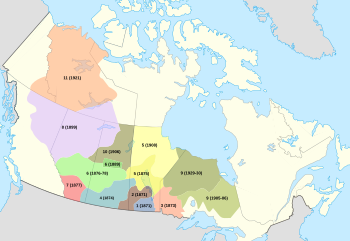
Back Numbered Treaties German Traités numérotés French Trattati Numerati Italian 番号付きインディアン条約 Japanese Tratados numerados Portuguese Numaralı Antlaşmalar Turkish Нумеровані договори Ukrainian
 Map of Numbered Treaties of Canada. Borders are approximated. | |
| Context | Treaties to transfer large tracts of land from the First Nations to the Crown in return for different promises laid out in the treaty |
|---|---|
| Signed | 1871–1921 |
| Signatories | Key representatives of the Canadian Crown: Adams George Archibald, Alexander Morris, David Laird, Duncan Campbell Scott, Wemyss Mackenzie Simpson, S.J. Dawson, William J. Christie, James McKay, James Macleod, James Hamilton Ross, J.A.J. McKenna, Samuel Stewart, Daniel G. MacMartin, Henry Anthony Conroy, Key representatives of First Nations groups: Crowfoot (Blackfoot Confederacy), Big Bear (Cree Nation), Chief Powassin (Ojibwe Nation), Chief Keenooshayoo (Athabasca First Nations) |
| Languages | English |
The Numbered Treaties (or Post-Confederation Treaties) are a series of eleven treaties signed between the First Nations, one of three groups of Indigenous Peoples in Canada, and the reigning monarch of Canada (Victoria, Edward VII or George V) from 1871 to 1921.[1] These agreements were created to allow the Government of Canada to pursue settlement and resource extraction in the affected regions, which includes the entirety of modern-day Alberta, Manitoba, and Saskatchewan, as well as parts of modern-day British Columbia, Ontario, the Northwest Territories, Nunavut, and Yukon. These treaties expanded the Dominion of Canada with large tracts of land in exchange for promises made to the indigenous people of the area. These terms were dependent on individual negotiations and so specific terms differed with each treaty.
These treaties came in two waves—Numbers 1 through 7 from 1871 to 1877 and Numbers 8 through 11 from 1899 to 1921. In the first wave, the treaties were key in advancing European settlement across the Prairie regions as well as the development of the Canadian Pacific Railway. In the second wave, resource extraction was the main motive for government officials.
Today, these agreements are upheld by the Government of Canada, administered by Canadian Aboriginal law and overseen by the Minister of Crown–Indigenous Relations. They are often criticized and are a leading issue within the fight for First Nation rights. The Constitution Act, 1982 gave protection of First Nations and treaty rights under Section 35. It states: "Aboriginal and treaty rights are hereby recognized and affirmed."[2] This phrase was never fully defined. As a result, First Nations must attest their rights in court as the case in R v Sparrow.
- ^ "Numbered Treaty Overview". Canada in the Making. Canadiana.org. Archived from the original on 9 April 2004. Retrieved 16 November 2009.
The Numbered Treaties - also called the Land Cession or Post-Confederation Treaties - were signed between 1871 and 1921, and granted the Government of Canada large tracts of land throughout the Prairies, Canadian North and Northwestern Ontario for white settlement and industrial use. In exchange for the land, Canada promised to give the Aboriginal peoples various items, such as cash, blankets, tools, farming supplies, and so on. The impact of these treaties can be still felt in modern times.
- ^ "PART II: RIGHTS OF THE ABORIGINAL PEOPLES OF CANADA". Justice Laws Website. Government of Canada. 9 March 2015. Retrieved 10 March 2015.
© MMXXIII Rich X Search. We shall prevail. All rights reserved. Rich X Search